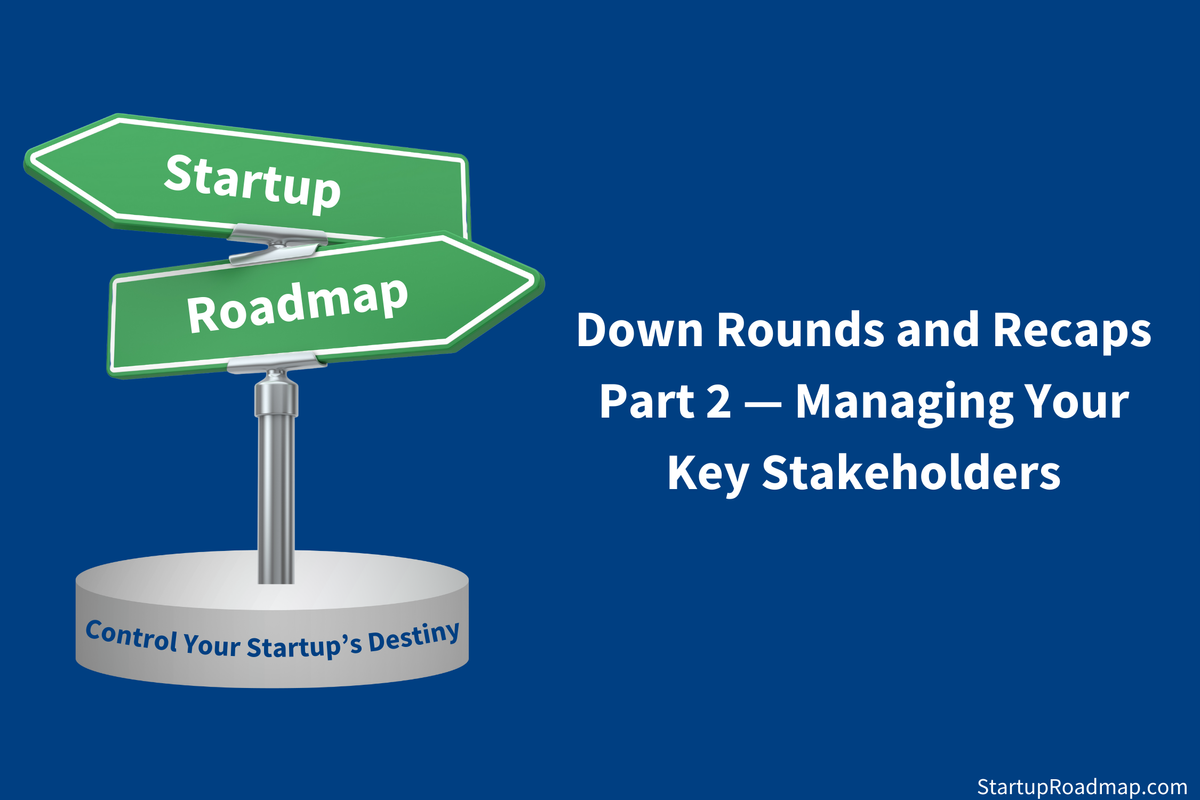Down Rounds and Recaps Part 2 – Managing Your Key Stakeholders

Welcome to part two of our series on down rounds and recaps:
- Part 1: A Guide to Down Rounds and Recaps
- Part 2: Managing Your Key Stakeholders <- You are here
- Part 3: A Deep Dive Into Down Rounds
- Part 4: Navigating the Startup Recap
Let’s get into it.
Down rounds and recaps are not just a math problem. They are a people problem.
The process of executing a down round or recap requires the careful balancing of the needs and expectations of three groups of stakeholders.
- Your investors: In between successful exits, your investors need the markups in their portfolios from subsequent funding rounds at higher valuations. These markups increase their fund’s internal rate of return, which keeps their LPs happy and supports raising their next fund.
- Your employees: They want to know that their stock options are becoming more valuable. It’s the justification they need to accept below-market pay and above-market hours. It keeps them from jumping to other startups in search of the big win.
- You and your co-founders: You’re fighting to continue your startup journey. You still believe in your vision. You believe you can overcome your recent setbacks and realize the value you set out to build so long ago.
Before we dive into the execution of down rounds and recaps, we need to focus on managing these stakeholders throughout this process.
Your investors
There are three keys to managing your investors through a down round or recap.
Understand your startup’s governance process
Once you’ve raised a priced round of funding, your board will be comprised of a combination of preferred investors, independent directors, and founders.
Board Directors have a fiduciary responsibility to protect the company’s interests. Those directors who are preferred investors also have a responsibility to their venture fund to optimize results for the best possible return from each investment.
Depending on your startup’s charter or bylaws, decisions that affect the rights and economics of your investors might require approval by common shareholders, the board of directors, or a supermajority of preferred shareholders.
These rules vary from startup to startup.
Take the time with your legal counsel to understand the approval threshold and process for any transaction you may be contemplating. This knowledge lets you lay out a clear game plan for achieving your goals.
Your investors may have different motivations
- Since 2000, only the top 25% of venture funds produced returns that meaningfully outperformed the S&P 500.
- The bottom 50% of venture funds consistently underperformed the market. (Note 1)
A venture fund’s performance and track record can impact your investors’ behavior and decisions.
Experienced investors running high-performing funds understand that write-offs and write-downs are par for the course. They have a track record and portfolio that allows them to support you when it’s time to make difficult decisions.
Less experienced, less successful investors can become obstacles you need to navigate. They can’t absorb a lower valuation in a portfolio already suffering. They can’t write another check, subjecting them to the risk of pay-to-play and a cram down.
Understanding these dynamics and the process for approving any plan is essential as you start counting the votes you’ll need.
Embrace game theory through clear communication and transparency
As you can see, you face a landscape filled with varying agendas and levels of risk:
- Board directors doubling as preferred investors
- Preferred investors with diverse experience and success levels
- Potentially outside investors pushing aggressive terms
This dynamic can create a complex decision-making framework rooted in game theory. No one wants to give up rights they don’t have to, nor unnecessarily cede an advantage to another investor.
Clear, proactive communication of your startup’s challenges is essential. Executing a down round or recap is a journey, and you need to bring your board and investors along early if you want their support.
This may require you to invest time moving through several steps that ultimately prove to be futile:
- Running a fundraise process to validate the market
- Engaging a banker to attempt an M&A process
- Modeling wind-down scenarios to document the impact on each stockholder.
Work with your board to figure out what process makes the most sense. Don’t skip steps. The transparency and thoroughness of your process will build trust, avoiding the traps that game theory can present.
Your employees
By the time you’ve started down the path of a down round or recap, your employees will know that things are not going according to plan.
You executed a round of layoffs. You pulled the plug on unproductive projects you were championing only months before. Budgets are getting tighter, and approvals for new initiatives are coming slower.
There are two keys to getting your employees through a down round or recap.
Reset to achievable goals
Down rounds and recaps allow you to reset your milestones. You can set achievable goals that keep you Default Investable on a new path to future funding.
Set a plan your employees can believe in. If you’re at this stage in your startup journey, you and your team have likely been on a breathless sprint, chasing a higher valuation, for quite some time.
Now that you’ve decided to reset your valuation, get your team off the hamster wheel. Set goals they believe in. Do fewer things better.
Reset the potential of their equity incentives.
Down rounds and recaps significantly impact your employee’s equity incentives.
- Options end up underwater, with strike prices higher than the value of the stock.
- Dilution lowers their ownership percentage, another hit to the potential value of their awards.
You need to address both issues, particularly for key employees critical to the next stage of your journey. This will generally require a fresh option pool with which you can issue new grants at your new, lower strike price.
As with the rest of this process, work with your legal counsel and board to devise the best plan for your situation.
But be proactive.
Do this planning as you model and execute a down round or recap. Saving it to the end will only make it harder to do.
Let's not forget about you
Now, read that last section again, but make it about you this time.
- You need to set goals that you believe in.
- You need to genuinely believe that the capital you’re raising will enable you to reach new milestones that will keep you on the venture track.
- You must ensure your equity incentives align with your role, commitment, and a fair outcome if you can successfully navigate the challenges ahead.
Executing down rounds and recaps is an emotionally draining experience. Everything you worked so hard for can feel like it’s slipping away.
But here’s the truth.
Most venture-backed startups hit this wall. Many never recover.
If you can successfully execute a down round or a recap, reset your goals, and have the capital to try again, you’ve accomplished yet another herculean task along the startup journey.
You didn’t commit to ‘Go Big or Go Home’
Down rounds and recaps can have severe consequences for your existing investors. But that’s just part of the risk of investing in early-stage startups.
This doesn’t mean you should take it lightly. As soon as you raised that first round of outside venture investment, you committed to doing your best to generate venture-scale returns for your investors.
But let’s face reality. A study by Sebastian Quintero demonstrated that more than 90% of venture-backed startups fail to reach their Series C or find a path to an exit. (Note 2)
Experienced investors understand this. They build portfolios of startups, betting on the handful of exceptional outcomes that will produce the returns of their entire fund.
For you, this startup is your one current shot on goal.
You are not obligated to drive your startup into the ground in an all-out effort to show your investors that you did everything possible.
Down rounds and recaps are legitimate tools in the founder’s toolbox; when necessary, you should understand how to use them.
Time to get tactical
In our next issue, we’ll dive into the down round. We’re going deep on the topic of valuation, breaking down the concept of dilution, and exploring the concept of negative signaling and how to deal with it.
Footnotes:
1 – Venture Capital Is The Best Performing Investment Of The Past 25 Years
2 – Dissecting startup failure rates by stage by Sebastian Quintero




